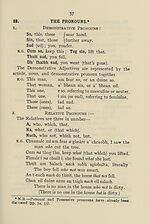Download files
Complete book:
Individual page:
Thumbnail gallery: Grid view | List view

58
No change for gender or number comes over these relatives,
and the only change for case is in the relative a, which, after
prepositions, takes the form an, and takes am before b, f,
m, p.
K.G. An taigh anns an robh e, the house in which he was.
An t-aite aig am bi e, the place at which he will be.
As there is no difference between the nominatives and
accusatives of a and nach, the relative clauses with transitive
active verbs are very ambiguous. For example, the
sentence, Reic e an t-each a bhuail mi, may mean :—
He sold the horse which kicked me, or,
He sold the horse which I struck.
The difficulty here might be got over by using the word
“ breab ” for kick, and keeping “ buail ” for strike.
But, again, in many sentences it is difficult to avoid
the ambiguity.
E.G. An cat a mharbh an radan, might mean
The cat which killed the rat, or
The rat which killed the cat.
Am fear nach cuala mi,
The man who not heard me, or
The man whom not I heard,
meaning, “ the man who did not hear me,” and “ the man
whom I heard not,” respectively.
In most cases, however, the context should be able to
settle the more probable reading.
XV.—leughadh.
De tha sin, a Mhdiri ? Is e so maide mor. F^g am maide
sin air a’ bhord. Agus cait an cuir mi sud ? Tilg a
mach do ’n t-sloc ud e. Cait an robh a’ bhean ud ?
Bha i anns an taigh sin. Co leis an litir sin ? Tha i le
No change for gender or number comes over these relatives,
and the only change for case is in the relative a, which, after
prepositions, takes the form an, and takes am before b, f,
m, p.
K.G. An taigh anns an robh e, the house in which he was.
An t-aite aig am bi e, the place at which he will be.
As there is no difference between the nominatives and
accusatives of a and nach, the relative clauses with transitive
active verbs are very ambiguous. For example, the
sentence, Reic e an t-each a bhuail mi, may mean :—
He sold the horse which kicked me, or,
He sold the horse which I struck.
The difficulty here might be got over by using the word
“ breab ” for kick, and keeping “ buail ” for strike.
But, again, in many sentences it is difficult to avoid
the ambiguity.
E.G. An cat a mharbh an radan, might mean
The cat which killed the rat, or
The rat which killed the cat.
Am fear nach cuala mi,
The man who not heard me, or
The man whom not I heard,
meaning, “ the man who did not hear me,” and “ the man
whom I heard not,” respectively.
In most cases, however, the context should be able to
settle the more probable reading.
XV.—leughadh.
De tha sin, a Mhdiri ? Is e so maide mor. F^g am maide
sin air a’ bhord. Agus cait an cuir mi sud ? Tilg a
mach do ’n t-sloc ud e. Cait an robh a’ bhean ud ?
Bha i anns an taigh sin. Co leis an litir sin ? Tha i le
Set display mode to:
![]() Universal Viewer |
Universal Viewer | ![]() Mirador |
Large image | Transcription
Mirador |
Large image | Transcription
| An Comunn Gàidhealach > An Comunn Gàidhealach Publications > Elementary course of Gaelic > (70) |
|---|
| Permanent URL | https://digital.nls.uk/196027669 |
|---|
| Description | This contains items published by An Comunn, which are not specifically Mòd-related. It includes journals, annual reports and corporate documents, policy statements, educational resources and published plays and literature. It is arranged alphabetically by title. |
|---|
| Description | A collection of over 400 items published by An Comunn Gàidhealach, the organisation which promotes Gaelic language and culture and organises the Royal National Mòd. Dating from 1891 up to the present day, the collection includes journals and newspapers, annual reports, educational materials, national Mòd programmes, published Mòd literature and music. |
|---|---|
| Additional NLS resources: |
|

